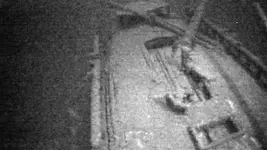DeepseekerADS
Gold Member
- Joined
- Mar 3, 2013
- Messages
- 14,880
- Reaction score
- 21,745
- Golden Thread
- 0
- Location
- SW, VA - Bull Mountain
- Detector(s) used
- CTX, Excal II, EQ800, Fisher 1260X, Tesoro Royal Sabre, Tejon, Garrett ADSIII, Carrot, Stealth 920iX, Keene A52
- Primary Interest:
- Other
- #1
Thread Owner
NY-based explorers find 1868 schooner wreck in Lake Ontario | Fox News
Published June 30, 2016 Associated Press

This photo from video provided by Jim Kennard shows the the stern of the shipwrecked Canadian schooner Royal Albert that sank off Lake Ontario's central New York shore nearly 150 years ago. ((Courtesy of Jim Kennard via AP))
ALBANY, N.Y. — The shipwreck of a Canadian schooner that sank off Lake Ontario's central New York shore nearly 150 years ago has been discovered, a team of underwater explorers announced Wednesday.
Jim Kennard, Roger Pawlowski and Roland Stevens said they recently found the wreck of the Royal Albert in deep water off Fair Haven, 35 miles northwest of Syracuse. The western New York-based team said the 104-foot vessel was carrying 285 tons of railroad iron that shifted in rough conditions, bursting the ship's seams.
The crew survived the August 1868 sinking by getting into a small boat and making it to shore.
The wreck was found in mid-June using side-scan sonar, Kennard said. Video images taken by a remotely-operated vehicle helped identify the wreck as the Royal Albert, the only two-masted schooner known to have sunk off Fair Haven, he said.
Built in 1858 in Oakville, Ontario, the schooner departed Oswego on Aug. 9, 1868, headed to Toledo, Ohio, on Lake Erie, via Canada's Welland Canal. Kennard said the Royal Albert was only a few miles into its westward voyage when lake conditions turned rough, causing the cargo to shift and break apart the hull. The crew barely had time to scramble into a small boat as the ship sank, he said.
Video of the wreck shows both masts toppled over and some of the railroad rails can be seen in the aft hold, Kennard said. While the discovery isn't as significant as some of the many others the New York team has made during Lake Ontario explorations in recent years, Kennard said the find offers a glimpse into shipping methods and manifests in the post-Civil War period.
"It's essentially typical of how goods were being shipped and the kind of goods being shipped," he said. "The heavier commodities couldn't be shipped through the canals on canal boats."
Published June 30, 2016 Associated Press

This photo from video provided by Jim Kennard shows the the stern of the shipwrecked Canadian schooner Royal Albert that sank off Lake Ontario's central New York shore nearly 150 years ago. ((Courtesy of Jim Kennard via AP))
ALBANY, N.Y. — The shipwreck of a Canadian schooner that sank off Lake Ontario's central New York shore nearly 150 years ago has been discovered, a team of underwater explorers announced Wednesday.
Jim Kennard, Roger Pawlowski and Roland Stevens said they recently found the wreck of the Royal Albert in deep water off Fair Haven, 35 miles northwest of Syracuse. The western New York-based team said the 104-foot vessel was carrying 285 tons of railroad iron that shifted in rough conditions, bursting the ship's seams.
The crew survived the August 1868 sinking by getting into a small boat and making it to shore.
The wreck was found in mid-June using side-scan sonar, Kennard said. Video images taken by a remotely-operated vehicle helped identify the wreck as the Royal Albert, the only two-masted schooner known to have sunk off Fair Haven, he said.
Built in 1858 in Oakville, Ontario, the schooner departed Oswego on Aug. 9, 1868, headed to Toledo, Ohio, on Lake Erie, via Canada's Welland Canal. Kennard said the Royal Albert was only a few miles into its westward voyage when lake conditions turned rough, causing the cargo to shift and break apart the hull. The crew barely had time to scramble into a small boat as the ship sank, he said.
Video of the wreck shows both masts toppled over and some of the railroad rails can be seen in the aft hold, Kennard said. While the discovery isn't as significant as some of the many others the New York team has made during Lake Ontario explorations in recent years, Kennard said the find offers a glimpse into shipping methods and manifests in the post-Civil War period.
"It's essentially typical of how goods were being shipped and the kind of goods being shipped," he said. "The heavier commodities couldn't be shipped through the canals on canal boats."




